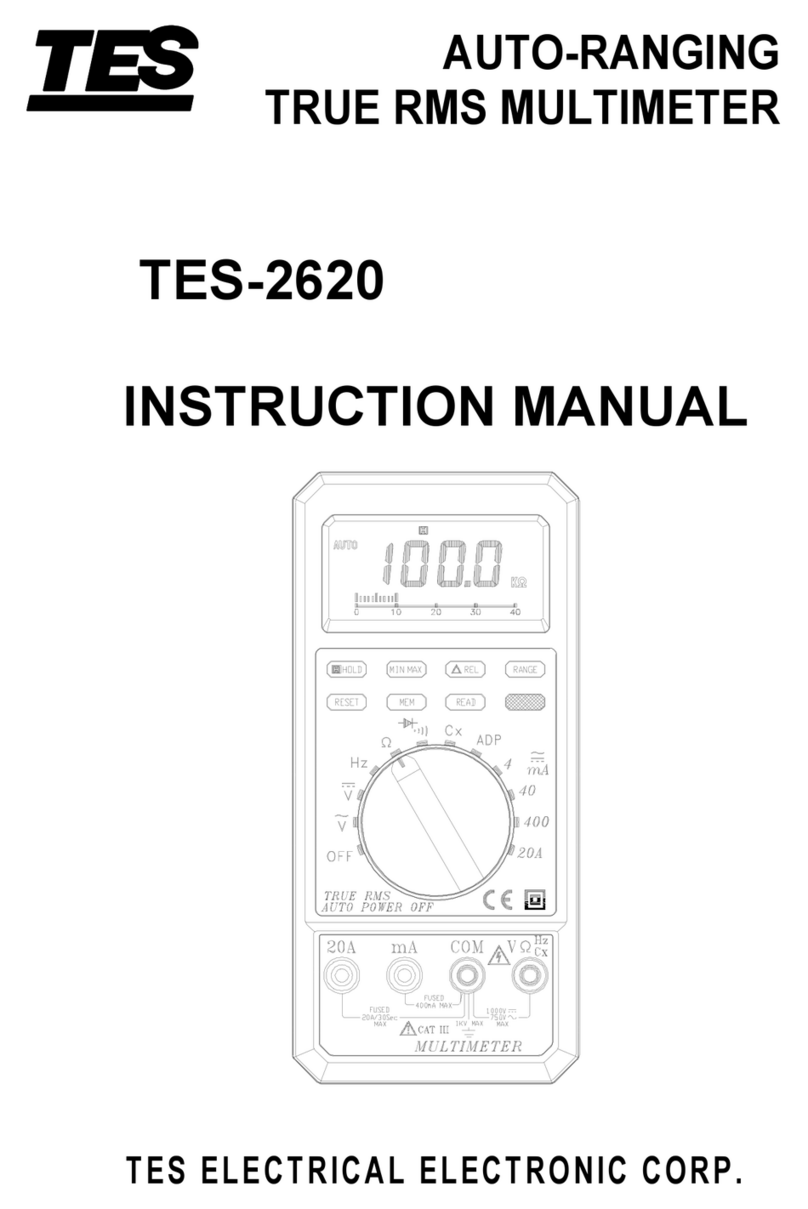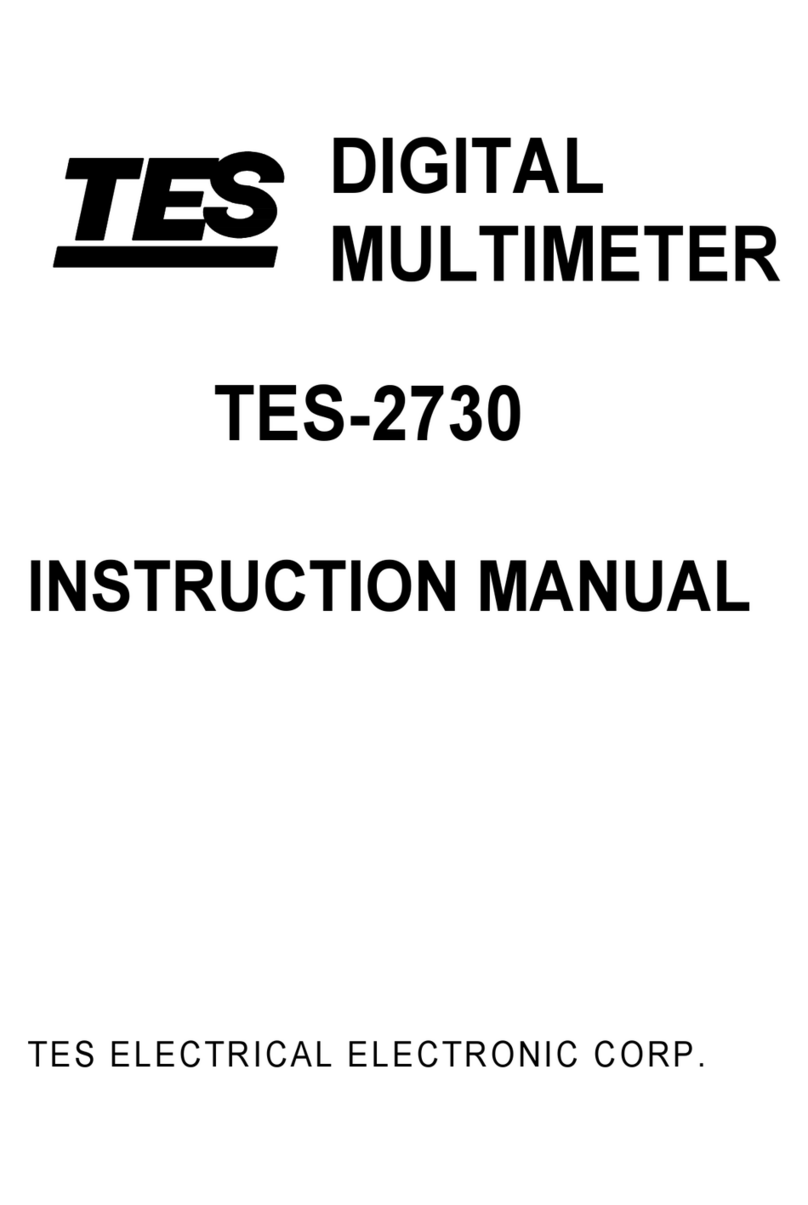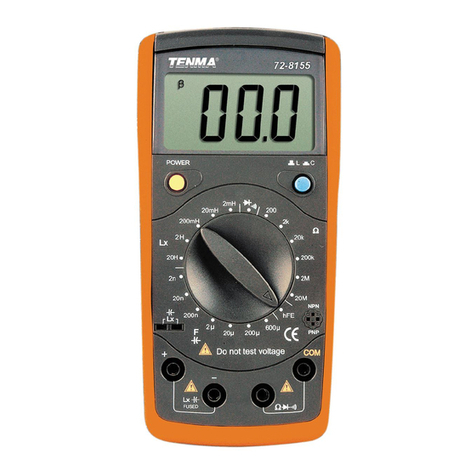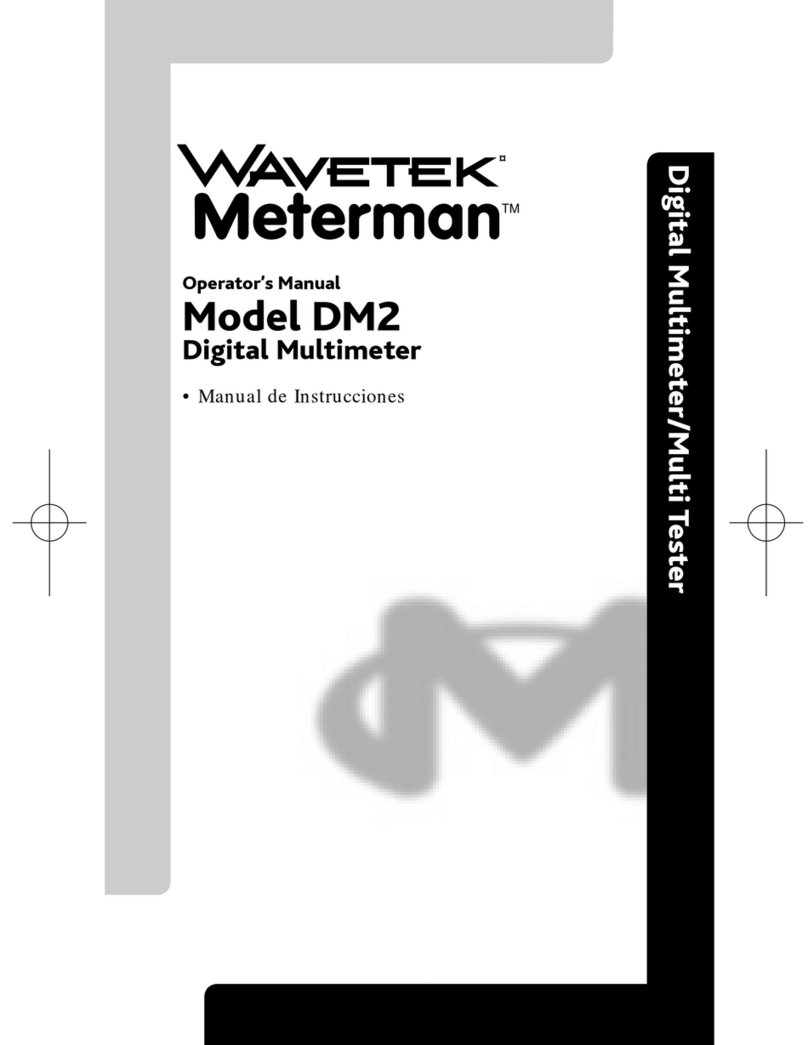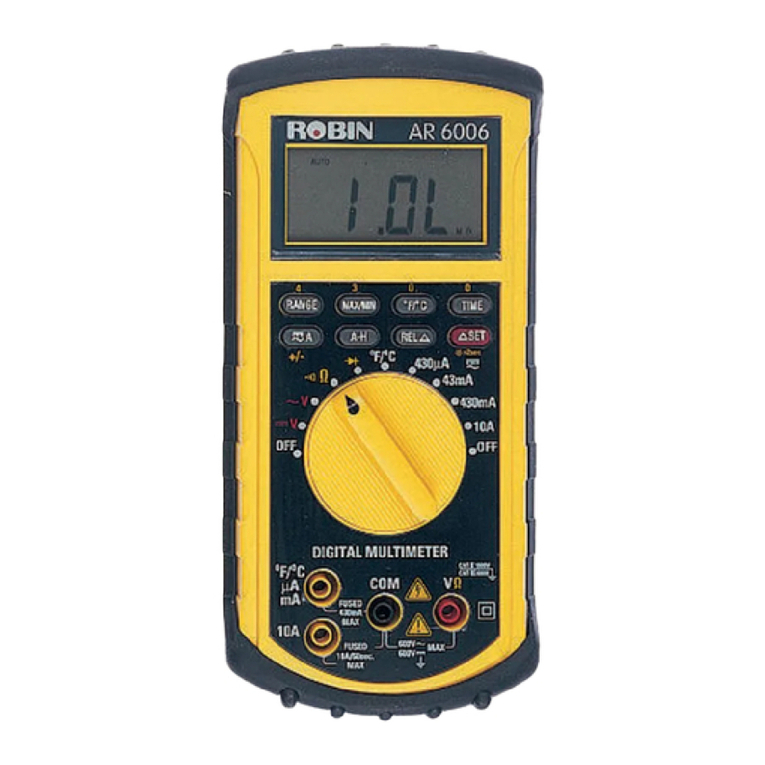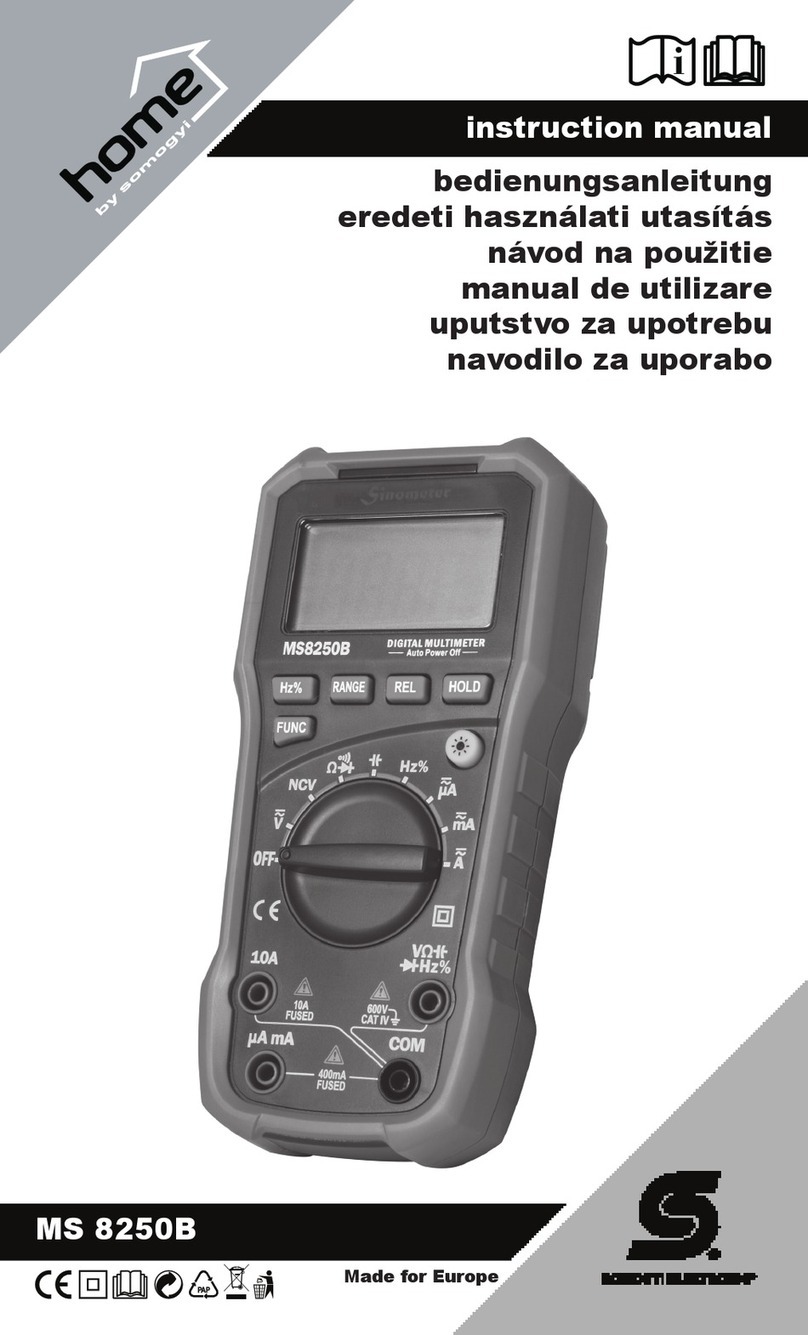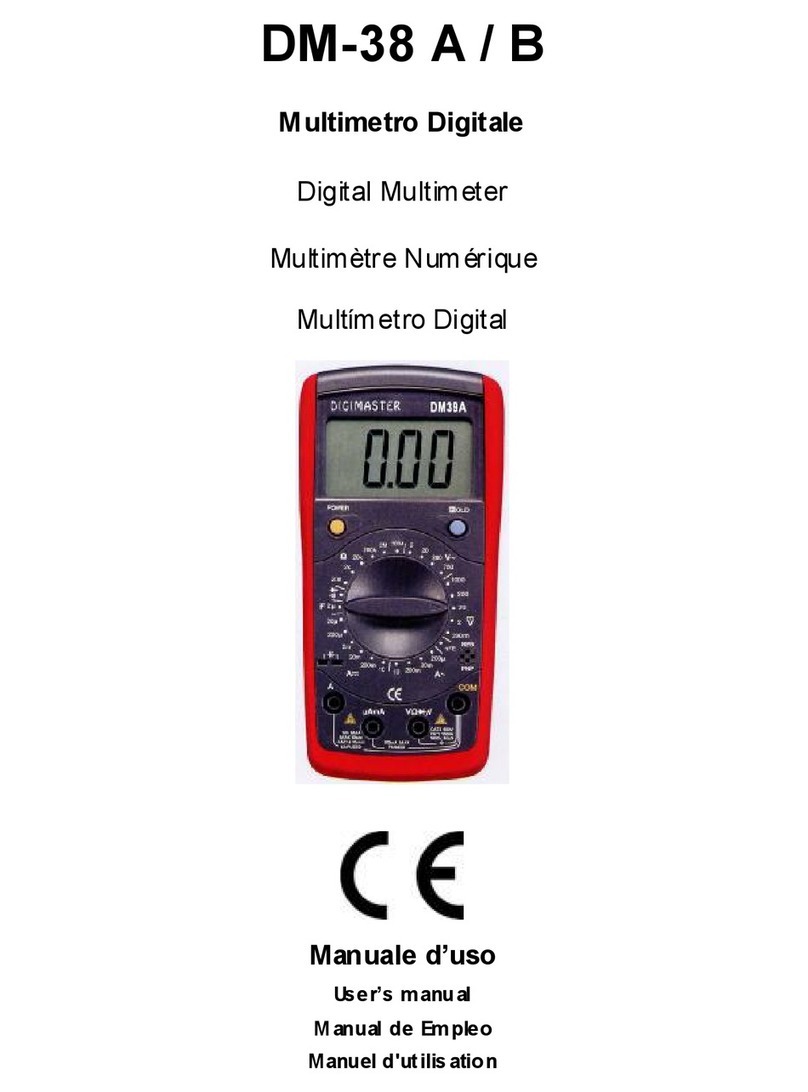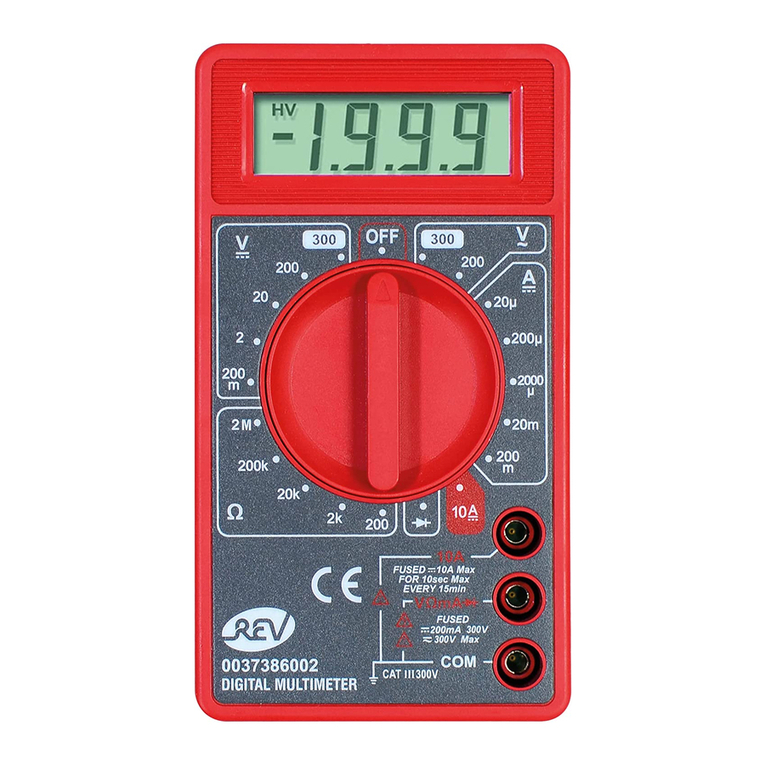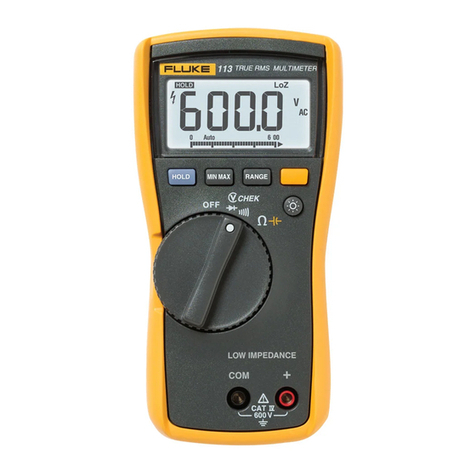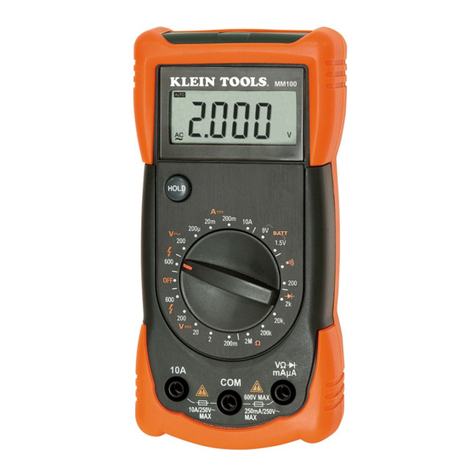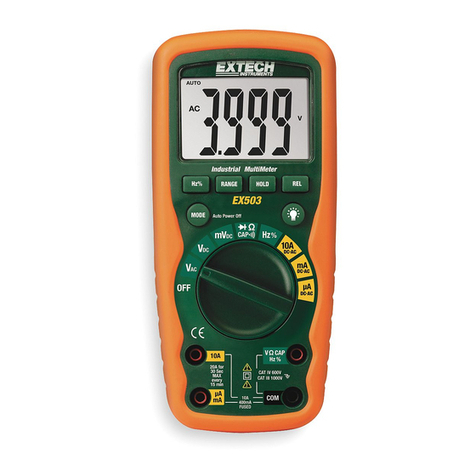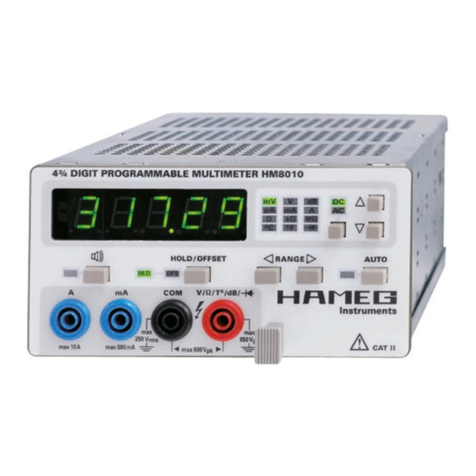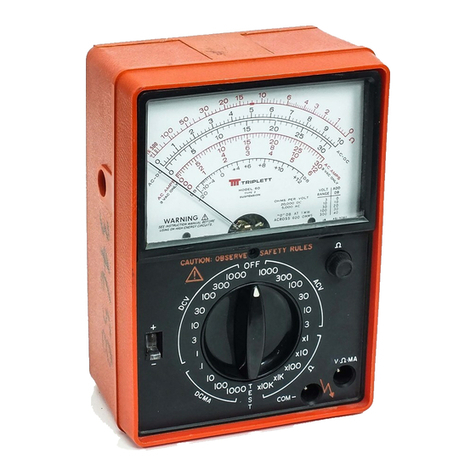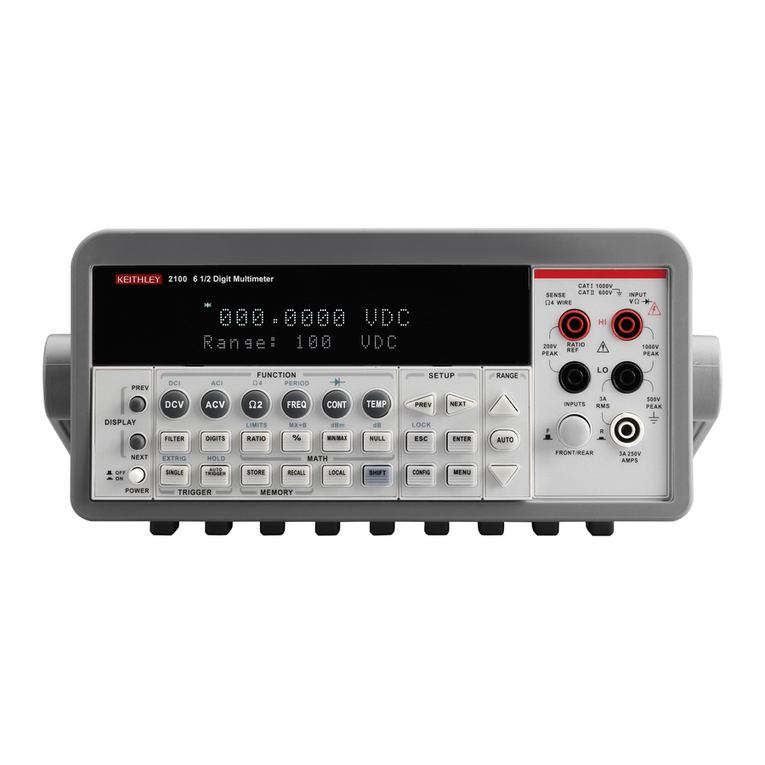TES TES-2700 User manual

AUTO - RANGING
DIGITAL MULTIMETER
TES-2700
INSTRUCTION MANUAL
TES ELECTRICAL ELECTRONIC CORP.
1. SAFETY INFORMATION
Read the following safety information carefully before attempting to
operate or service the meter.
To avoid damages to the instrument do not apply the signals which
exceed the maximum limits shown in the technical specifications tables.
Never measure current while the test leads are inserted into the input
jacks.
Do not use the meter or test leads if they look damaged. Use extreme
caution when working around bare conductors or bus bars.
Accidental contact with the conductor could result in electric shock.
Use the meter only as specified in this manual ; otherwise, the
protection provided by the meter may be impaired.
Read the operating instructions before use and follow all safety
information.
Caution when working with voltages above 60V DC or 30 V AC RMS.
Such voltages pose a shock hazard.
Before taking resistance measurements or testing acoustic continuity,
disconnect circuit from main power supply and all loads from circuit.
Safety symbols:
Caution refer to this manual before using the meter.
Dangerous voltages.
Meter is protected throughout by double insulation or
reinforced insulation.
When servicing, use only specified replacement
parts.
Comply with EN-61010-1
1

2. FEATURES
3-1/2 (3200 COUNTS) Digital LCD with Bar-graph
Auto- Ranging on Volt, Ohm , Current measurement
Auto-power off
Provides data HOLD mode
Ohms, Diode / Audible Continuity and Capacitance input Overload
protection to 500Vr ms
20A / 380V high energy fuse protection on 20A AC/DC
Flip - up stand
3. SPECIFICATIONS
3-1 General Information
Environment conditions :Installation Categories
II
Pollution Degree 2
Altitude up to 2000 meters
Indoor use only
Relatively humidity 80% max.
Operation Ambient 0〜40℃
maintenance & Clearing: Repairs or servicing not covered in this
manual should only be performed by
qualified personal.
Periodically wipe the case with a dry
cloth and detergent.
Do not use abrasives or solvents on this
instruments.
Operating Principle :
Dual slope integration
Numerical Display :3 1/2 digit liquid crystal display (LCD) maximum
reading 3260 and Bargraph indication.
2
Display Symbol Definition:
■
Decimal point
AC
Alternating current or voltage
DC
Direct current or voltage
V
Voltage
mV
Millivolt ( 1
×
10
-3
volt )
A
Ampere (amps) Current
mA
Milliampere ( 1
×
10
-3
amp )
Ω
Ohm. Resistance
KΩ
Kilohm ( 1
×
10
3
ohm ). Resistance
MΩ
Megohm (1
×
10
6
ohm ). Resistance
Diode
Continuity Beeper
Low Battery
Negative polarity
MANU
Manual Range
Date Hold
Range Selection :All ranges are selected by single Range Switch
operation.
Over Range Indication :LCD will show a “OL”.
Low Battery Indication :The is displayed when the battery
voltage drops below the proper operating
voltage.
Sampling Rate :12.5 times/sec of Bar-graph indication, 2 times
/sec of digital display
Power Source :2 pcs of “AAA” 1.5V Battery
3

Battery Life :500hrs approx.
Polarity :Automatic polarity “ “ indicates negative
input.
Auto Power Off Time :Approx. 10 minutes
Operating Temperature :0℃to 40℃( 32℉to 104℉)
and Humidity below 80% RH
Storage Temperature :-10℃to 60℃( 14℉to 140℉)
and Humidity below 70% RH
Dimensions :180 (L)
×
82 (W)
×
38(H) mm
Weight :Approx. 365
g
Accessories :Test leads, Spare fuse (0.5A/250V), Battery
and Instruction manual.
3-2 Electrical Specifications
Accuracies are ±(...% of reading + ...digits) at 23℃± 5℃,below 80% RH.
DC Voltage : (
Autoranging & Manual range )
Range Resolution Accuracy Input
Impedance
Overload
Protection
320mV 0.1mV > 100MΩ
3.2V 1mV 11MΩ
32V 10mV
320V 100mV
0.5%+2
600V 1V 0.8%+2
10MΩ
AC/DC 750V
4
AC Voltage
: 40Hz〜400Hz ( Autorange & Manual range )
Range Resolution Accuracy Input
Impedance Overload Protection
3.2V 100uV 11MΩ
32V 1mV
320V 10mV
600V 1V
1.2%+4 10MΩAC/DC 750V
DC Current :
(uA mA Autoranging & Manual Range)
Range Resolution Accuracy
Burden
Voltage Overload Protection
320uA 0.1uA 0.2V max
3200uA 1uA 1.8V max
32mA 10uA 1.2V max
320mA 100uA
1%+2
1.8V max
0.5A/250V fast blow fuse
& Diode
20A 10mA 1.5%+2 0.6V max
20A/380V fast blow fuse
10A Continuity
20A for 30 sec. max.
AC Current :
40Hz〜400Hz ( uA mA Autorange & Manual range )
Range Resolution Accuracy
Burden
Voltage Overload Protection
320uA 0.1uA 0.2V max
3200uA 1uA 1.8V max
32mA 10uA 1.2V max
320mA 100uA
1.5%+5
1.8V max
0.5A/250V fast blow fuse
& Diode
20A 10mA 2.0%+5 0.6V max
20A/380V fast blow fuse
10A Continuity
20A for 30 sec. max.
5

Resistance: ( Autoranging & Manual range )
Range Resolution Accuracy Open Circuit
Voltage
Overhead
protection
320Ω0.1Ω
3.2KΩ1
Ω
32KΩ10Ω
320KΩ100Ω
3.2MΩ1KΩ
0.8%+ 2
30MΩ10KΩ1.5%+ 3
1.3V 660Vrms
Diode Test: ( )
Range Resolution Short Circuit
Current Accuracy Open Circuit
Voltage
Overload
Protection
1mV 0.8mA typical 1%+ 2 3V 660Vrms
Audible Continuity:
Range Resolution Max Open Circuit Voltage Overload Protection
≦20Ω1.3V 660Vrms
6
4. PARTS & CONTROLS
4-1 Name of Parts and Positions:
(Fig-1)
7

1. 20A Measuring Connector :
To connect positive lead ( red test lead ) for current measurement
below 20A.
2. mA & uA Measuring Connector :
To connect positive lead ( red test lead ) for current measurement
bellow 320mA.
3. COM Measuring Connector :
To connect negative lead (black test lead) for current, resistance,
Diode, continuity, capacitor, ADP measurement.
4. VΩ
Measuring Connector :
To connect positive lead (red test lead) for voltage, resistance, diode,
continuity measurement.
5. Auto-Range & Manual-Range Button :
Press RANGE to select the Manual Range mode (The meter remains
in the range it was in when manual range is selected).
In the Manual Range mode, each time you press RANGE button, the
range ( and the input range annunciator ) increases, and a new value
is displayed.
If you are already in the highest range, the meter “ wraps around “ to the
lowest range. To exit the Manual Range mode and return to Auto
Range mode. Press and hold down RANGE for 2 seconds, the AUTO
annunciator tur ns back on.
6. AC/DC Current Select and
/
select Button:
a) To select function DC or AC current.
b) To select continuity measurements or Diode tests.
7. Date Hold ( ) Button :
Press it once to hold the measured value in dark place when reading
or recording is difficult, press it again to release the holding status.
8
8. LCD Display :
Measured values, unit, symbols, and decimal points are displayed.
9. Range Selector Switch :
For power on and power off and selection of desired range.
(Fig-2)
10. Negative Polarity :
Automatically indicating negative inputs
11. Manual-range Mode indicator.
Meter is in the autorange mode and will automatically select the range
with the best resolution. Meter powers on in autorange mode.
12. Low Battery :
As battery power is not sufficient. LCD will display .
13. Data Hold indicator.
14. Analog Display.
9

4-2 DC/AC Voltage Measurements
WARNING
Maximum Input Voltage at DC/AC Voltage Range is 600V
AC/DC. Do not attempt to take any voltage measurement
that may exceed to avoid electrical shock hazard and/or
damage to this instrument.
(1) Connect red test lead to “ VΩ” terminal and black test lead to
“ COM ” terminal.
(2) Set Range Switch to
V
or
V
range.
(3) Connect the test leads IN PARALLEL to the circuit being
measured.
(4) Read the Voltage value on LCD.
4-3 DC/AC Current Measurement
WARNING
Continuous measurements can be applied in 10A Range.
less that 30 seconds per measurements can be applied in
20A Range.
(1) Connect red test lead to the “mA/uA“ Terminal for Current
measurements up to 320mA. (For measuring Current between
320mA to 20A, Connect red test lead to “20A” terminal. )
Connect black test lead to “COM” terminal.
(2) Set Range Switch to desired A range. and press AC/DC switch
to DC/AC function.
(3) Cut the power to the circuit to be tested and Connect the
instrument IN SERIES with t he circuit with the black test lead on
the negative “-” side and the red lead on the positive “+“ side
being measured.
(4) Apply power and read the Current value on LCD.
10
4-4 Diode Tests
WARNING
Before taking any in-circuit measurement, remove power from
the circuit being tested and discharge all capacitors in the circuit.
(1) Connect red test lead to the " VΩ" terminal and black test lead to
the " COM" terminal.
(2) Set range switch to the diode test ""position and press
/
button to
function.
(3) Connect the red test lead to the anode side and black test lead to
the cathode side of the diode being tested.
(4) Read forward voltage (Vf) Value on LCD.
(5) If the polarity of test leads are reversed with diode polarity (3), the
digital reading should nearly equal to the reading in the open
circuit condition. This can be used for distinguishing anode and
cathode poles of a diode.
4-5 Resistance Measurement
WARNING
Before taking any in-circuit resistance measurement, remove
power from the test circuit being tested and discharge all
Capacitors.
(1) Connect red test lead to “ VΩ“terminal and black test lead to
“ COM” terminal.
(2) Set Range Switch to Ωrange.
(3) Connect test lead to the circuit being measured and read the
resistance Value on LCD.
11

4-6 Continuity Measurements
(1) Connect red test lead to “ VΩ” terminal and black test lead to
“ COM” terminal.
(2) Set Range Switch to the /
position, and press /
button to function.
(3) Remove power from the circuit being tested and discharge all
capacitors.
(4) Connect the Test Lead to the circuit being measured.
(5) When the impedance between the test terminal is lower than 20
Ω, it will activate a continuous beeper.
Note: Continuity Test is available to check open/short of the circuit.
12
5. BATTERY & FUSE REPLACEMENT
WARNING
To prevent electrical hazard or shock, turn off multi-meter and
disconnect test leads before removing back cover.
5-1 Battery Check-Up & Replacement
(1) As battery power is not sufficient, LCD will display “
".
Replacement of Two new batteries type AAA 1.5V is required.
(2) Set Range Switch to “ OFF “ position. Use a screw drive to
remove the rear cover. Take out the battery and replace them
with two new batteries of type AA 1.5V.
(3) Place back the rear cover and secure it with the original screw.
5-2 FUSE Replacement
(1) Set Range Switch to “ OFF “ position. Use a screw drive to
remove rear cover. Take out the malfunction fuse and replace it
with a new fuse rate 0.5A/250A ( or 20A/600V ) of fast blow type.
(2) Place back the rear cover and secure it with the original screw.
13

TES ELECTRICAL ELECTRONIC CORP.
7F, No. 31, Lane 513, Rui Guang Road, Neihu Dist. Taipei.
Taiwan, R. O. C.
Tel : (02) 2799-3660
Fax : 886-2-2799-5099
E-Mail : tes@ms9.hinet.net Home page :
http://www.tes.com.tw
Feb-2002-4

Table of contents
Other TES Multimeter manuals
